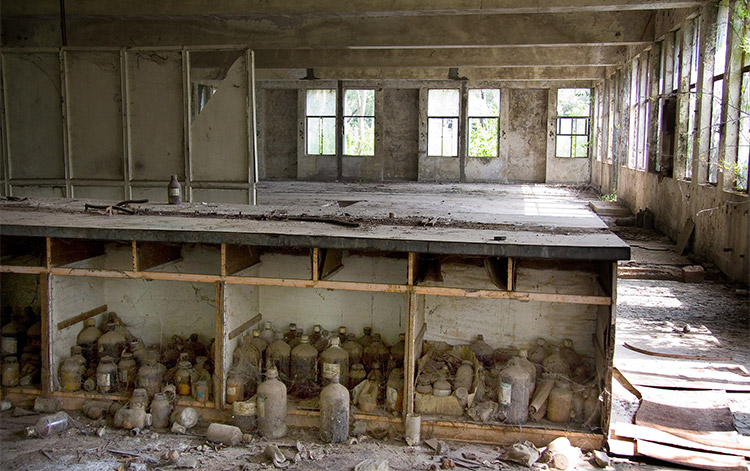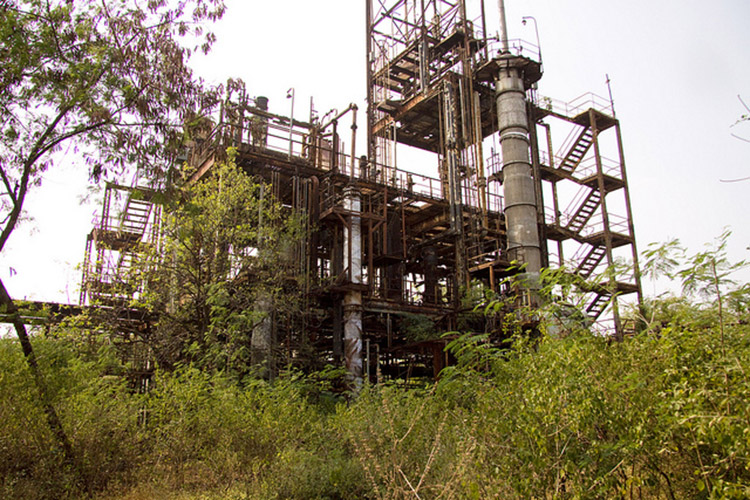UNEP offers contamination assessment of Bhopal disaster site to Government of India
In a significant development for the Bhopal Disaster case, the United Nations Environment Programme (UNEP) has offered to undertake a full evaluation of the spread of toxic waste at the derelict Union Carbide factory in Bhopal.

The Union Carbide factory in Bhopal was abandoned after the toxic gas cloud killed thousands of people in 1984: toxic chemicals have been leaching into the groundwater for decades (all pictures courtesy Bhopal Medical Appeal)
A full contamination assessment has never been made and toxic waste abandoned in and around the factory site continues to poison local residents over 30 years since the 1984 Bhopal Gas Tragedy most significantly by leeching into the groundwater aquifer that supplies their drinking water (see CRJ Volume 10:2 and 10:1 ).
This contamination disaster is a major public health issue affecting tens of thousands of poor people in the slum areas surrounding the abandoned Union Carbide pesticide factory. It is the second chemical disaster to befall Bhopal and is a separate matter from the 1984 Bhopal Gas Tragedy. There has been no settlement of any kind, no compensation has been paid, and there has been no attempt at meaningful environmental clean up.
UNEP has approached the Indian Government via the Ministry of Environment and Forest (MoEF). The Indian Government must formally invite UNEP to Bhopal and the Minister has asked for 15 days to consider the offer.
"It would be a comprehensive assessment of the 3.5 km area, that continues to affect inhabitants in some 22 colonies,” said Rachna Dhingra, representative for Bhopal Group for Information and Action (BGIA). She said that several studies have been undertaken since 1990 but none have been comprehensive.
Greenpeace issued a report, as early as 2002, Technical guidelines for clean-up at the Union Carbide India Ltd (UCIL) site in Bhopal, proposing assessment and treatment protocols: “The entire factory site and the surrounding areas, including the ‘solar evaporation pond’ areas where wastes have been landfilled, should be systematically sampled, using a grid pattern reinforced with extra samples at visibly contaminated locations. Samples should be collected from the surface and at regular depths to establish the extent of subsoil contamination… if those furthest from the site show any signs of contamination, the testing area should be extended until no further contamination is detectable.”
By 2009, a round of tests performed by Delhi-based Centre for Science and Environment (CSE) showed the greatest pesticide contamination (in ground water samples) at Shiv Nagar a distance of 3.5km to the North East of the UCIL site. Further tests, any greater distance away from the factory site, are yet to be performed.

Colin Toogood, Bhopal Medical Appeal spokesman says: "There are 22 communities, comprising around 50,000 people, now officially acknowledged as affected by the contaminated groundwater; but the unfortunate truth is that nobody knows how far the contamination has spread into the aquifer and, thus, how many communities are actually affected. They cannot possibly know this until a full contamination survey is finally performed- nor can they know how many people are still being poisoned in Bhopal’s 'Second Disaster'.
"The contamination situation in Bhopal is an environmental crisis and a medical emergency. We welcome UNEP’s offer and insist that the Ministry of Environment and Forest issue a formal invitation.”